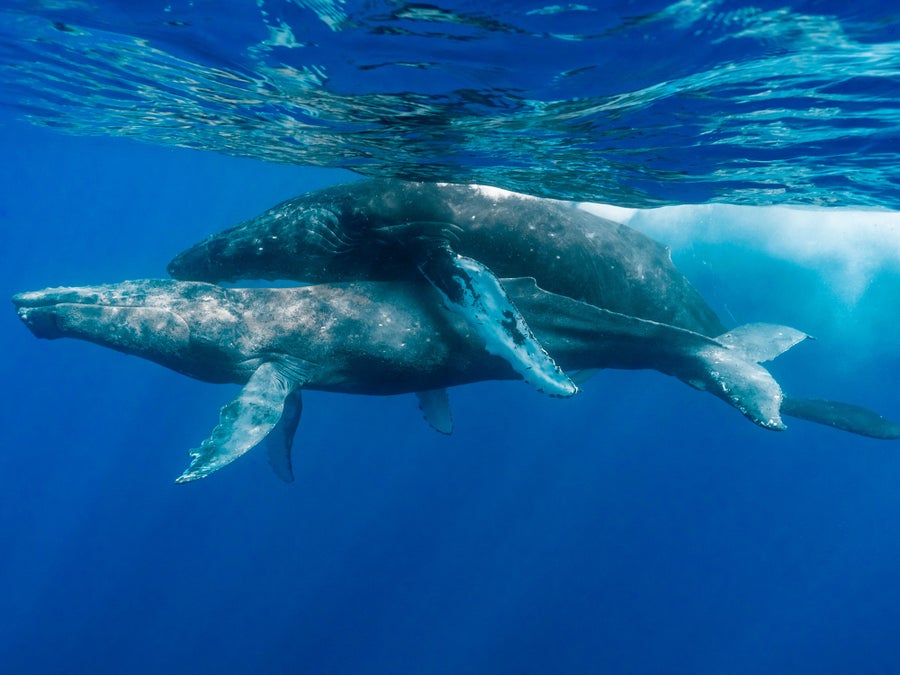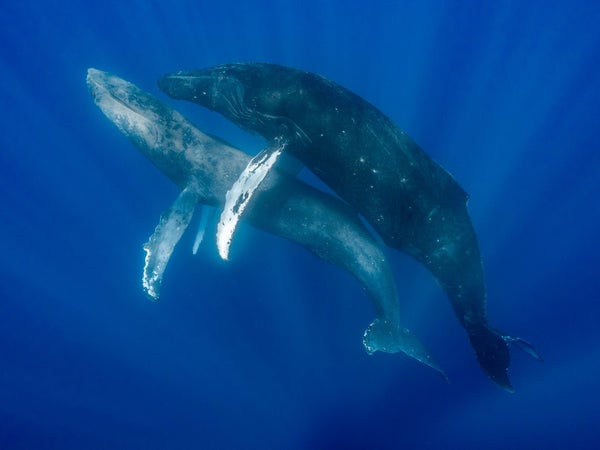Humpback Whale Sex Observed for the First Time Ever, between Two Males
Humpback Whale Sex Observed for the First Time Ever, between Two Males
Photographers captured a healthy male humpback penetrating a weaker individual in the first record of humpback whale sex
A male humpback whale dubbed Whale B was seen copulating with another male, Whale A, in the first-ever documented case of humpback whale mating.
Lyle Krannichfeld and Brandi Romano
Each year humpback whales travel thousands of miles from their polar feeding grounds to the tropical waters where they mate, give birth and nurse their calves. But despite the breeding season attracting tourists and scientists from around the world, sexual behavior among humpback whales had never been documented—until now.
And the world’s first photographs of humpback whales copulating are even more groundbreaking because both individuals were male.
The surprising images, published this week in a paper in Marine Mammal Science, were recorded by chance. In January 2022 Lyle Krannichfeld and Brandi Romano—two photographers based on the Hawaiian island of Maui—saw something strange. Two whales slowly swam toward their boat. Whale B kept approaching Whale A from behind, holding on with his pectoral fins and copulating with Whale A; each penetration lasted for less than two minutes.
On supporting science journalism
If you’re enjoying this article, consider supporting our award-winning journalism by subscribing. By purchasing a subscription you are helping to ensure the future of impactful stories about the discoveries and ideas shaping our world today.
The photographers knew sexual activity between humpbacks had never been scientifically observed or documented. But when they approached Stephanie Stack, a researcher at the Pacific Whale Foundation, for confirmation of what they’d seen, she noticed something else: “I said, ‘Oh, it doesn’t look like a female whale,’” says Stack, the new paper’s lead author.
Whale B had inserted his penis into Whale A’s genital slit, the opening that sheathes the penis when it is not extruded for mating. The penetrations were very shallow because “the humpback whale’s penis is quite large,” Stack says.
Images of each whale’s tail fluke, which can be used to identify an individual as effectively as a human fingerprint, were cross-checked on the global Happywhale.com database to confirm that both whales were sexually mature males. Whale A was at least 13 years old, and Whale B was around 30.
“Homosexual behavior is extremely common in the animal kingdom and very common for other species of cetaceans,” Stack says. Same-sex sexual acts play an important social role for common bottlenose dolphins (Tursiops truncatus), and homosexuality has been seen in other whales, dolphins and porpoises, including killer whales (Orcinus orca), gray whales (Eschrichtius robustus), bowhead whales (Balaena mysticetus) and Amazon river dolphins (Inia geoffrensis).
Homosexual acts have also been seen in other types of animals. For Octopoteuthis deletron, a squid living in the ocean’s twilight zone, coming across a potential mate is so rare that males randomly shoot sperm packets at any individual they encounter from their own species—male or female. And even though species of flatworms are hermaphrodites (organisms with both male and female reproductive organs), they duel with their penis to impregnate a mate and avoid the energetic cost of laying eggs themselves.
On land, same-sex sexual activity has been recorded in bonobos, flamingos, bison, geese, dragonflies and more.
There can be many reasons for homosexual behavior in the ocean: practicing mating, forming social bonds, reducing tension and showing dominance or aggression. But why were these two males doing it?
“It’s important to not look at this through a human perspective,” Stack notes. But she does have theories. It could, she says, be a way of developing social bonds—or male humpbacks could be in a heightened hormonal state during mating season.
“In the heat of the moment, they will seek anything they can find,” says Olaf Meynecke, a research fellow at Griffith University in Australia, who was not involved in the study but studies humpback whales.

Researchers don’t yet know what role same-sex sex acts might play in humpback whales, but such activity has been noted numerous species, particularly other cetaceans.
Credit: Lyle Krannichfeld and Brandi Romano
A third possibility is that this was a show of dominance. “Males on the breeding grounds do compete against other males,” Stack says. The photographs in the paper show Whale A lifting his head, arching his lower back and lowering his tail, forming an S-shape—a position whales sometimes assume when feeling threatened or stressed.
What’s more, Whale A was sick. He was emaciated, and his body was covered in whale lice (Cyamus boopis), turning him a brownish color. These parasites live on a humpback’s skin and can multiply rapidly when the host is injured or sick. A serious jaw injury, probably from a boat strike, was likely the cause of this particular whale’s poor health because it affected his ability to feed. “It looks like the other male took advantage of the weak individual,” Meynecke says. Whale B was seen the following year, but there have been no more sightings of Whale A. Although not all whales are seen every year—so he might still return—the jaw injury may have been fatal.
Seeing whale copulation for the first time gives researchers more information about how it occurs, as well as the respective positions the whales can assume during mating. This will help them know what to look out for in the field or when reviewing existing data. “A pair of adult whales together may not have drawn a researcher’s attention under normal circumstances,” Stack says. “Now that we know this, maybe we’ll look a little more carefully.”
The new paper also shows the value of citizen science: having more people on the water with cameras can sometimes increase the chance of formally documenting new behaviors. “It would be nearly impossible to specifically design a study and hope to capture whales mating,” Stack says. “Maybe someday we’ll see mating between a male and a female humpback.”
Humpback Whale Sex Observed for the First Time Ever, between Two Males
Photographers captured a healthy male humpback penetrating a weaker individual in the first record of humpback whale sex

A male humpback whale dubbed Whale B was seen copulating with another male, Whale A, in the first-ever documented case of humpback whale mating.
Lyle Krannichfeld and Brandi Romano
Each year humpback whales travel thousands of miles from their polar feeding grounds to the tropical waters where they mate, give birth and nurse their calves. But despite the breeding season attracting tourists and scientists from around the world, sexual behavior among humpback whales had never been documented—until now.
And the world’s first photographs of humpback whales copulating are even more groundbreaking because both individuals were male.
The surprising images, published this week in a paper in Marine Mammal Science, were recorded by chance. In January 2022 Lyle Krannichfeld and Brandi Romano—two photographers based on the Hawaiian island of Maui—saw something strange. Two whales slowly swam toward their boat. Whale B kept approaching Whale A from behind, holding on with his pectoral fins and copulating with Whale A; each penetration lasted for less than two minutes.
On supporting science journalism
If you’re enjoying this article, consider supporting our award-winning journalism by subscribing. By purchasing a subscription you are helping to ensure the future of impactful stories about the discoveries and ideas shaping our world today.
The photographers knew sexual activity between humpbacks had never been scientifically observed or documented. But when they approached Stephanie Stack, a researcher at the Pacific Whale Foundation, for confirmation of what they’d seen, she noticed something else: “I said, ‘Oh, it doesn’t look like a female whale,’” says Stack, the new paper’s lead author.
Whale B had inserted his penis into Whale A’s genital slit, the opening that sheathes the penis when it is not extruded for mating. The penetrations were very shallow because “the humpback whale’s penis is quite large,” Stack says.
Images of each whale’s tail fluke, which can be used to identify an individual as effectively as a human fingerprint, were cross-checked on the global Happywhale.com database to confirm that both whales were sexually mature males. Whale A was at least 13 years old, and Whale B was around 30.
“Homosexual behavior is extremely common in the animal kingdom and very common for other species of cetaceans,” Stack says. Same-sex sexual acts play an important social role for common bottlenose dolphins (Tursiops truncatus), and homosexuality has been seen in other whales, dolphins and porpoises, including killer whales (Orcinus orca), gray whales (Eschrichtius robustus), bowhead whales (Balaena mysticetus) and Amazon river dolphins (Inia geoffrensis).
Homosexual acts have also been seen in other types of animals. For Octopoteuthis deletron, a squid living in the ocean’s twilight zone, coming across a potential mate is so rare that males randomly shoot sperm packets at any individual they encounter from their own species—male or female. And even though species of flatworms are hermaphrodites (organisms with both male and female reproductive organs), they duel with their penis to impregnate a mate and avoid the energetic cost of laying eggs themselves.
On land, same-sex sexual activity has been recorded in bonobos, flamingos, bison, geese, dragonflies and more.
There can be many reasons for homosexual behavior in the ocean: practicing mating, forming social bonds, reducing tension and showing dominance or aggression. But why were these two males doing it?
“It’s important to not look at this through a human perspective,” Stack notes. But she does have theories. It could, she says, be a way of developing social bonds—or male humpbacks could be in a heightened hormonal state during mating season.
“In the heat of the moment, they will seek anything they can find,” says Olaf Meynecke, a research fellow at Griffith University in Australia, who was not involved in the study but studies humpback whales.

Researchers don’t yet know what role same-sex sex acts might play in humpback whales, but such activity has been noted numerous species, particularly other cetaceans.
Credit: Lyle Krannichfeld and Brandi Romano
A third possibility is that this was a show of dominance. “Males on the breeding grounds do compete against other males,” Stack says. The photographs in the paper show Whale A lifting his head, arching his lower back and lowering his tail, forming an S-shape—a position whales sometimes assume when feeling threatened or stressed.
What’s more, Whale A was sick. He was emaciated, and his body was covered in whale lice (Cyamus boopis), turning him a brownish color. These parasites live on a humpback’s skin and can multiply rapidly when the host is injured or sick. A serious jaw injury, probably from a boat strike, was likely the cause of this particular whale’s poor health because it affected his ability to feed. “It looks like the other male took advantage of the weak individual,” Meynecke says. Whale B was seen the following year, but there have been no more sightings of Whale A. Although not all whales are seen every year—so he might still return—the jaw injury may have been fatal.
Seeing whale copulation for the first time gives researchers more information about how it occurs, as well as the respective positions the whales can assume during mating. This will help them know what to look out for in the field or when reviewing existing data. “A pair of adult whales together may not have drawn a researcher’s attention under normal circumstances,” Stack says. “Now that we know this, maybe we’ll look a little more carefully.”
The new paper also shows the value of citizen science: having more people on the water with cameras can sometimes increase the chance of formally documenting new behaviors. “It would be nearly impossible to specifically design a study and hope to capture whales mating,” Stack says. “Maybe someday we’ll see mating between a male and a female humpback.”
